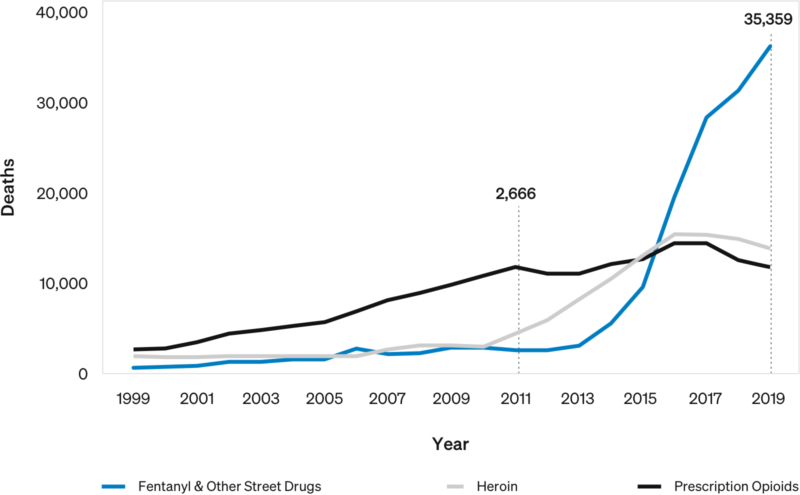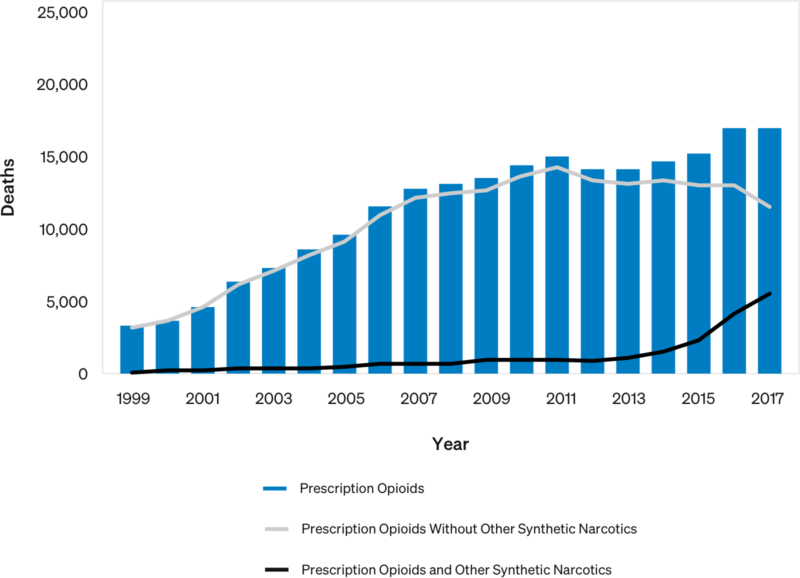Fentanyl Driving Opioid Crisis
Opioid overdoses continue to rise, primarily due to illicit drugs including fentanyl, which are trafficked into the United States from China and Mexico.
Despite the overwhelming evidence that illicit fentanyl – along with polysubstance use – is driving the opioid epidemic, there continues to be a crackdown on prescription opioid prescribing habits (and intense legal scrutiny towards the entire prescription opioid supply chain), which has resulted in many chronic pain patients losing access to necessary pain medications.
“This makes little sense. Purdue and the Sacklers have been abundantly punished by litigation, but now that they’ve been shunted away, America’s addiction problem continues to worsen, these days with fentanyl (which is manufactured generically and often illicitly) instead of any Sackler-linked drug as the primary scourge.”
November 2022[1]
Illicit Fentanyl & Polysubstance Use Fueling Opioid Crisis
“Drug-Overdose Deaths Reached a Record in 2021, Fueled by Fentanyl”
May 2022[2]
“The nation no longer has a prescription opioid-driven epidemic.”
June 2020[3]
“Fentanyl, a drug up to 50 times the strength of heroin, has ratcheted up risks for drug users. There is a legal form, sometimes prescribed for managing cancer pain, but the main problems are illicit forms made in clandestine labs in Mexico, according to U.S. law-enforcement authorities. These cartel-made drugs then pour through the U.S. border, often hidden in vehicles traveling through border checkpoints.”
May 2022[2]
CDC & DEA data show:
- Deaths from fentanyl and other synthetic opioids (excluding methadone) increased more than 2669% from 2011 to 2022.
- In 2011 there were 2,666 deaths. In 2022 that number rose to 73,838.[4]
- Prescription opioids were involved in less than a sixth of opioid deaths in 2022. Most recent data shows[4]:
- Illicit fentanyl and other synthetic opioids (excluding methadone) involved in 90.2% (up from 12% in 2011).
- Heroin involved in 7.2%.
- Rx opioids involved in 14.5%
“DEA seized more than 50 million fake pills and 10,000 pounds of fentanyl powder equating to approximately 379 million deadly doses of fentanyl”
February 2023[5]
DEA: Fentanyl Remains the Most Significant Opioid Threat[6]
“Reducing prescriptions has not reduced opioid-related deaths.”
– Journal of Pain Research, February 7, 2019[8]
- 2012-2022: Prescriptions for opioid medications decreased by 49.4%[9]
- 2022 American Medical Association report says reductions in opioid prescriptions has not led to reductions in opioid overdoses due to influx of fentanyl[10]
U.S. Drug Overdose Deaths vs. Opioid Prescription Rates 1990-2017[11]
U.S. Drug Overdose Deaths Involving Opioids: 1999–2019[4]

“The FDA’s latest move to reconsider opioids’ effectiveness comes amid the most devastating drug crisis in U.S. history. Over 80,000 Americans die each year from opioid overdoses — though the vast majority are caused by illicit opioids like fentanyl, not common prescription drugs like morphine or hydrocodone.
Because of the crisis, Americans’ attitudes toward prescription opioids have shifted sharply. Many public health and pain treatment experts, in fact, believe that the pendulum has swung too far: Instead of potentially addictive opioids being handed out too easily, they argue, the drugs have become too difficult to access, especially for pain patients who’ve used them for years without issue.”
April 2023[12]
“Policymakers still operate under the assumption that too many opioids are being prescribed. Overdose deaths — including those among adolescents — are now overwhelmingly caused by street fentanyl, not prescription medications. And fatalities have nearly doubled since 2012, in concert with the decline of the medical supply.”
Maia Szalavitz, Public policy and addiction reporter, January 2023[13]
Overdose Deaths Involving Prescription Opioids Alone Peaked in 2011
Deaths from prescription opioids alone peaked in 2011[14] and were responsible for approximately 6% of opioid overdose deaths in 2019 (and no more than 4% of all drug-related deaths), according to the CDC.[15]
- 2016-2021: Deaths specifically from oxycodone decreased 21%[16]
- 2020: Misuse of prescription opioids fell for the fifth consecutive year[17]
National Drug Overdose Deaths Involved Prescription Opioids (All Ages): 1999-2017[18]



